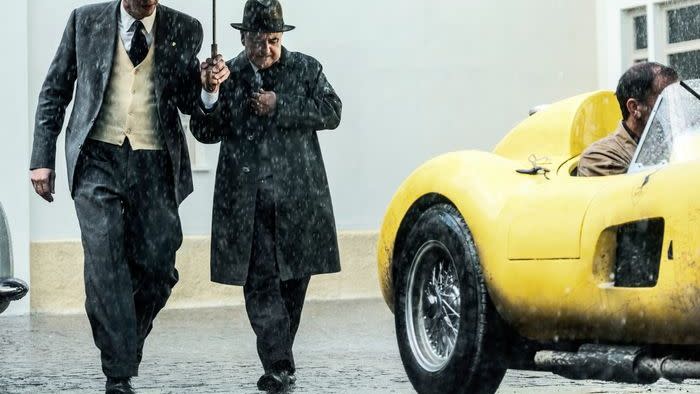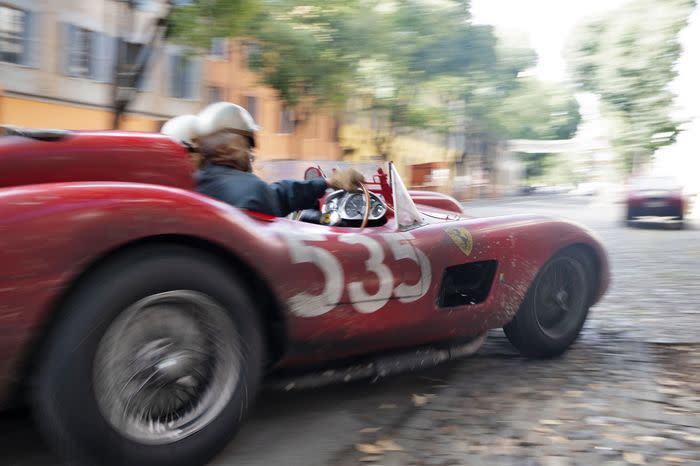Ferrari the Movie Is Skidding at the Box Office

Ferrari the movie opens with a disappointing $16 million first week.
Why? Who knows? The main character wasn't very likeable, true, but then, neither was Jar Jar Binks and that movie made bank.
There's still time for audiences to warm up to it, let's hope.
It seemed like it had everything: big stars, big budget, and a main subject that everyone knows. Yet Ferrari the movie seems to have screeched to a halt without ABS and hit a bridge abutment after its opening Christmas/New Year’s week.
So far, the $98 million megamovie has garnered only $11.8 million on domestic big screens and another $4 million internationally. It made only $6.8 million on its first four days. In its first week at the box office it ranked eighth—behind Wonka, Aquaman Dos, and The Color Purple, among others. A less-than $16 million opening week for a movie that cost that much to make does not bode well.
The best thing to do at times like these is to try Monday morning quarterbacking. (It’s especially good to do if you know absolutely nothing about making movies!)

Why is almost no one going to see it? Ford v Ferrari made $225 million just four years ago (and topped $31 million in its opening weekend), while that script had Ferrari right in the title. So it can’t be the cars.
The cars in Ferrari were magnificent, particularly the Maserati 450 S driven by Derek Hill as Jean Behra, and the Ferrari 315 S and 335 S that were driven by their hero drivers. But also consider the simple Alfa Romeo Berlinetta in which Laura Ferrari is driven around, and the Peugeot 403 Enzo himself drives—and double clutches so superbly.
Even the Lancia cabriolet that picks up Jean Behra from the train station is magnifico. And don’t get me started on those perfectly preserved period-correct buses and trucks we see in backgrounds throughout the film. It was like a tour through several Italian car museums all at once.
I’m going to say the problem with the movie is that the main character just isn’t sympathetic. No one was rooting for Enzo Ferrari to win anything. He was portrayed as a sort of anti-hero, which he may have been by 1957. Adam Driver played Enzo Ferrari with a focused and near-complete lack of emotion.
Granted, he cracks a tear at his son Dino’s castle-like mausoleum, and he does seem to take a direct interest, shall we say, with Penelope Cruz on that kitchen table.
But all throughout that he never changes expression. He walks quickly through every scene like he’s delivering a Door Dash order of rigatoni quattro formaggio for an angry high-tipper and he doesn’t want to lose the tip. He never smiles.
Yet if you look up photos of the real Enzo Ferrari he’s smiling all over the place. The book, Una Vida Per l’Automobile, which gets Enzo’s byline, has page after page of a smiling Enzo, often surrounded by teammates, friends and co-workers. You don’t convince the world’s greatest engineers to work for you without some charm, at least.
And Laura Ferrari, played with Oscar-aiming greatness by a stew-simmering Cruz, likewise doesn’t crack a grin in the whole two hours. Granted, she has plenty of reasons to be so somber. We root for her because we’re not rooting for Enzo.
The only memorable “fun” scene was when Patrick Dempsey, playing Piero Taruffi, asks Ferrari for an ash tray in his 335 S. He smiles!
Or maybe it was the whole premise of the movie, that Ferrari the company will be bankrupt unless the team wins the Mille Miglia, which was pretty much made up for scriptural purposes. And the fake-out of Ford in order to get Fiat financial backing wasn’t part of the 1957 season at all—it came about six years later.
And (cover your screen if you don’t want a spoiler) that gruesome crash scene was just way too gruesome. That could have been done using the “violence implied” approach rather than the, “Hey look! A spinal column!” approach director Michael Mann used. Yes, racing was dangerous back then.
Director Mann has had big hits before: Miami Vice in 2006 cleared $165 million; 2004’s Collateral made $217 million, Public Enemies $212 million. But he’s had just as many movies that earned less than they cost to make. His other bio-pic, Ali, didn’t pay back its budget.
Ultimately, though, making blockbusters is hard. The main ingredient is a simple stew of good characters in conflict, with the underdog winning in the end. Think of the first Rocky, the first Mad Max, the first Star Wars ($11 million budget!). Heck, Pulp Fiction was made for a mere $8 mil.
Ferrari the movie still has a few foreign markets in which to open, and those guys'll go see anything, so it could pick up a little. Overall, though, if you want Hollywood to make more movies about the cars you love, do your part and go see Ferrari. Just cover your eyes after the crash scene.
Did you see it? Did you like it? Let us know below.

 Yahoo Autos
Yahoo Autos 